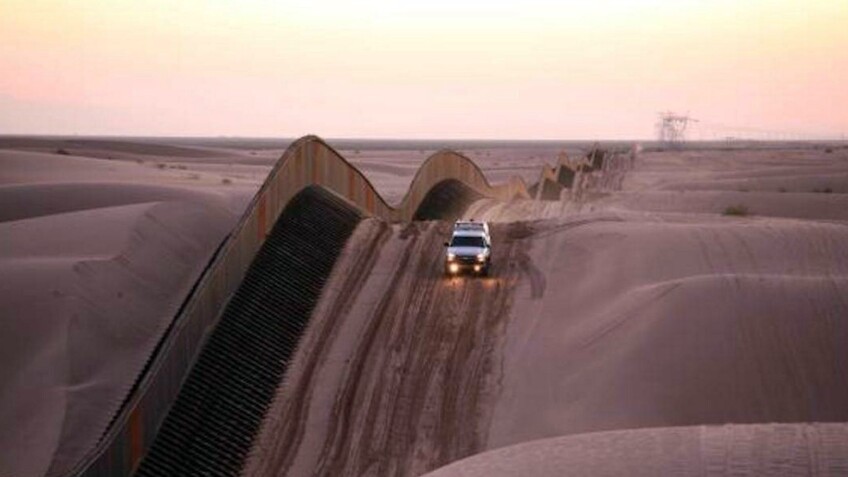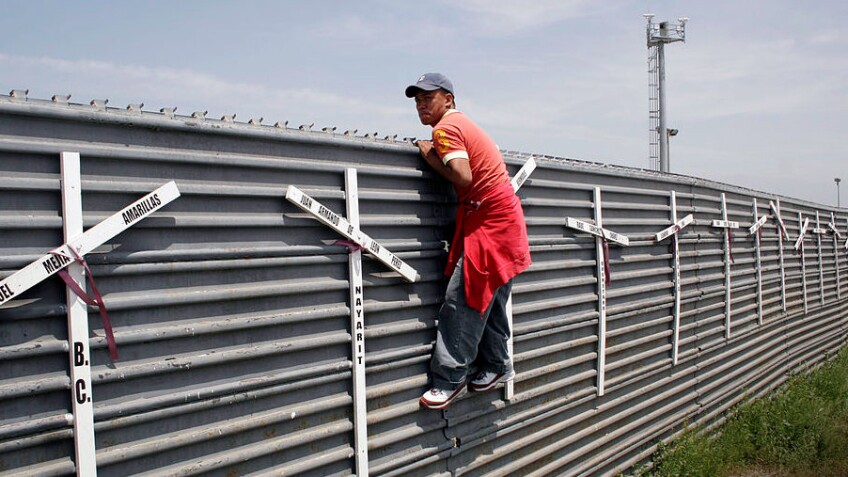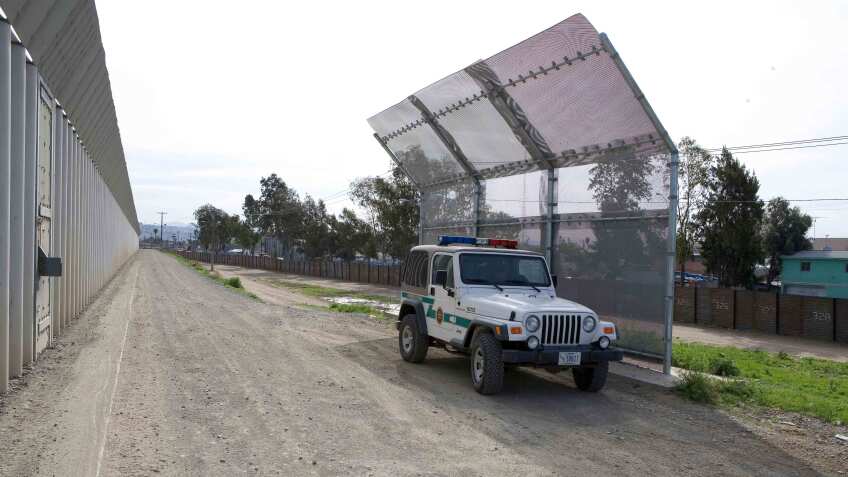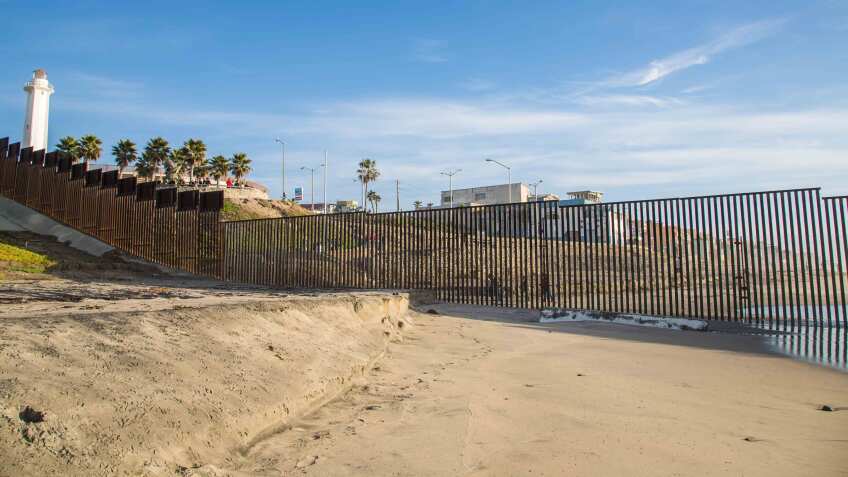Six Things to Know About California's Border

for CALmatters
1. There already is a wall along about a third of the border
The border runs about 1,900 miles from the Pacific Ocean to the Gulf of Mexico. Some sort of barrier—made from concrete, steel mesh and/or barbed wire —currently stands along about a third of it, in areas U.S. Customs and Border Protection deems vulnerable to illicit cross-border activity. Some segments are a solid metal wall; others are composed of various materials and have spaces between barriers or mesh, making those sections less a wall than a fence. Types include:
- Primary fencing, typically 18 feet high with steel bollards or pickets to impede pedestrians and vehicles.
- Secondary fencing, typically 15 feet high and constructed with horizontal rails in the form of steel tubes and fence fabric that is either mesh or perforated metal sheeting.
Along the existing wall or fence, 36 miles have double fencing with both primary and secondary barriers, and 14 miles have three layers of fencing, according to Customs and Border Protection. The San Diego area is one of the most fortified, with 46 miles of primary fencing and 14 miles of secondary fencing—and enough room to accommodate the road that runs between them. In addition, the federal government patrols some border areas by using drones, ground sensors, cameras and thousands of agents on the ground.
“There is some very good and very effective fencing and other infrastructure in place now, but it is only a fraction of the border. Some of it is outdated or wearing out and in a lot of places they need to extend it and in a lot of places they need to make it more effective by adding another layer,” said Jessica Vaughan, director of policy studies for the Center for Immigration Reform in Washington D.C., which supports immigration restrictions.

2. Even Donald Trump hasn’t maintained that the U.S. should build a wall along the entire southern border
Originally President Trump said he wanted a solid wall, 35 to 40 feet high, but later he backed away from that and said it could include other types of barriers like fencing. The executive order he issued this past week says: “Wall shall mean a contiguous, physical wall or other similarly secure, contiguous and impassable physical barrier.”
But his order does not specify a wall or fence along every mile of the border. Even Trump himself, as early as last February, acknowledged in an MSNBC interview: “We don’t need 2,000 (miles), we need 1,000 because we have natural barriers...” There are also other prohibitions, such as a decades-old treaty with Mexico that bans any barriers from blocking the flow of rivers. And the Tohono O'odham Nation Native American reservation, which resides on border territory, has already said no to Trump’s plan. To override that tribal resistance, the Trump administration would need a congressional bill condemning the land and taking it from the reservation’s trust.
The executive order calls for, within 180 days, a study assessing southern border security, the geophysical and topographical aspects, and the availability of federal and state resources.
The new President is relying on authority granted by the Secure Fence Act of 2006, which mandated about 700 miles of barriers, of which at least 653 primary miles have been completed. The Act called for double fencing along most of the border, but only 36 miles of double fencing stands was ever finished. That overall project stalled because Congress did not fund the final phase.

3. Many miles along the border cannot support construction of a wall
The hundreds of miles of border that remain unfenced fall into three categories: those deemed too topographically challenging for wall-building because of mountains or other rugged and rough terrain, those on Native American reservation land, and spaces identified for fencing that was never completed because the last project ran out of money. The largest swath of border without a barrier is in Texas.

4. Critics say it’s not going to help
The proposal is “likely to lead down a very bad road,” said David Shirk, a border expert at the Washington D.C. Woodrow Wilson Center, a nonpartisan policy research organization. Critics insist it will create more dangerous conditions for migrants who do cross the border and won’t eliminate or reduce undocumented immigration. They point to studiesand government statistics showing that illegal immigration has been in decline for several years, due in part to the U.S. recession.
A recent poll by Fox News found that only about a third of Americans believe Trump will actually build a border wall—and only a third said they wanted him to do so.

5. A wall is not a new concept
A barrier or wall has been advanced by every administration since at least Ronald Reagan. After a wave of undocumented immigrants arrived from Mexico and Central America in the 1980s—fleeing economic crisis and civil wars—the Reagan administration beefed up border security with more personnel and surveillance. In the early 90s, local officials began calling for physical barriers near urban points of entry. The first walls to be built along the border were made of corrugated metal that had been landing strips during the Vietnam War. Those barriers led people to attempt crossings in harsher and more dangerous areas. After 9/11, more barriers went up.

6. It’s still unclear what it will cost—or who’s going to pay for it
President Trump originally said his wall would cost about $8 to $12 million. Other cost estimates have run much higher. As a rough comparison, when the existing border barrier was built, it cost an average of nearly $4 million per mile, according to theGovernment Accountability Office.
Trump also had famously promised that Mexico would pay for it. But the very day the new President’s order was issued, Mexico’s president said his country would not do so. The Trump administration responded by suggesting a 20 percent import tax on Mexican goods, but press secretary Sean Spicer later told reporters that the tax is just one possible way to pay for the wall.
Although some news accounts reported that last week House Speaker Paul Ryan had committed Congress to paying $12 to $15 billion for the Trump wall, here’s what Ryan said: “The point is, we’re going to finance the Secure Fence Act, which is the construction of the physical barrier on the border.” Remember, the intent of that Act, passed under the Bush administration, was to double-fence just 700 miles of the border—almost all of which have at least a single barrier now.
CALmatters.org is a nonprofit, nonpartisan media venture explaining California policies and politics.